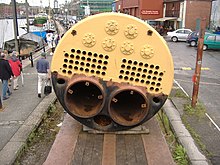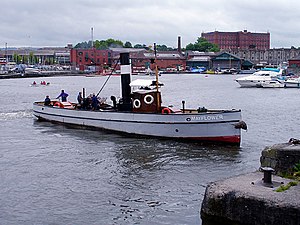|
Mayflower (tugboat)
Mayflower is a steam tug built in Bristol in 1861 and now preserved by Bristol Museums Galleries & Archives. She is based in Bristol Harbour at M Shed (formerly Bristol Industrial Museum). She is the oldest Bristol-built ship afloat, and is believed to be the oldest surviving tug in the world.[1] BuildingMayflower was built by Stothert & Marten (later G.K. Stothert & Co),[2] who were connected with the Bath-based engineering company Stothert & Pitt. A branch of the family came to Bristol to build railway locomotives (later to become the Avonside Engine Company). After 1852, a separate shipbuilding company was established which survived in business until the 1930s. The tug has an iron hull. She is 63.3 ft (19.3 m) long, her beam is 12.0 ft (3.7 m), her depth is 7.2 ft (2.2 m) and her tonnage is 32 NRT. Her United Kingdom official number is 105412.[3] ServiceMayflower was built for the towage contractor Timothy Hadley to work on the Gloucester and Sharpness Canal and in the River Severn,[2] one of three tugs ordered after trials by the Canal Company had shown they were much more efficient than horse-drawn boats. Altogether they cost £3,000.[4] The other two tugs were Moss Rose (1860) and Violet (1862).[5] Mayflower started work between Sharpness and Gloucester Docks, towing trains of small sailing vessels such as trows and ketches, and, after the new docks at Sharpness were completed in 1874, larger steamers one at a time. During 1874, she was purchased (along with Hadley's four other tugs; the initial three had been joined by Myrtle and Hazel[5]) by the Canal Company, which had by then renamed itself the Sharpness New Docks & Gloucester & Birmingham Navigation Co.. By the late 1890s she was the most seaworthy tug in the fleet, and she was altered to make her suitable for work in the Bristol Channel. Her original single-cylinder engine was replaced in 1899 with a vertical two-cylinder compound condensing engine supplied, along with a new boiler, funnel, propeller and shafting by W Sisson & Co of Gloucester for £940.[2] The steering position, which had previously been abaft the funnel, was moved forward, and a waist high iron steering shelter added to give the skipper some comfort. She went back to work outside Sharpness, towing sailing vessels through the dangerous stretches of the Severn Estuary to the mouth of the river Wye and back again. Around 1907, the Canal Company decided to compete on the River Severn upstream of Gloucester to Worcester.[6] In 1909 Mayflower was again altered when the funnel was arranged to hinge down (counterbalanced with large weights which can still be seen) to enable her to pass under the fixed bridges on this stretch of water. She as also fitted with another new boiler, made by G.K. Stothert (No. 303) and costing £298;[7] this boiler is still in the tug.[8] She was now capable of working on every part of the navigation from Worcester to Chepstow, and because of this, became regarded as the training tug in the canal's fleet, which she continued to be until the end of her working life. In 1922, she was again altered when the entire deck was raised by 12 inches (300 mm) which meant that the area beneath the deck at the stern could become another cabin albeit with very low headroom. At the same time the bulwarks were cut away down most of each side and replaced with stanchions and chains; this reflected the increased barge traffic on the canal, allowing the crew to step onto laden barges easily.[6] In the late 1930s, a wooden wheelhouse replaced the steering shelter, and some time after this the bulwarks were replaced. In 1948 the British Waterways Board took over the canal and made efforts to modernise the tug fleet. Between 1949 and 1962 all the former Canal Company steam tugs were sold, scrapped or had diesel engines installed. The exception to this was Mayflower, as she was too old to be worth bothering with. She was given the job of 'mudding tug' – towing the mud hopper barges filled by the canal dredger to the discharge point. Sometimes she was needed to turn ships at Sharpness Docks and assist them in the entrance lock. In 1962–1963, when the winter was so cold that the canal froze and the diesel tugs had difficulty in working, Mayflower once again took on ship-towing work in the canal. Finally, British Waterways sold Mayflower to Mr H. E Morgan in 1967.[9] Morgan was the managing director of Nordman Construction, who were demolishing the nearby Severn Railway Bridge at the time. After Nordman ran into financial difficulties demolishing the bridge, she was sold at auction to Mr Kevin Donaghy and Mr Anthony Barratt on 21 May 1969.[10] After being sunk by vandals at her mooring in Victoria Basin around Easter 1977, she was to be auctioned on 9 July 1977, but the auction was called off due to negotiations with Bristol Museums.[11] The negotiations failed as a price could not be agreed upon.[12] PreservationOn 4th April 1981 she was auctioned,[12] and purchased for £3600 by curator Paul Elkin of Bristol Museums & Art Gallery. She was then towed back to the city where she was built.[6] Over the next six years Mayflower was restored to working order by a team of volunteers, and she steamed again in 1987. Early in 1988, she steamed back to Gloucester on a courtesy visit.[6] Mayflower regularly steams during the summer months carrying visitors on trips in Bristol Harbour. She marked her 150th anniversary in May 2011.[13]  Mayflower had her boiler re-tubed in 2020[14] and returned to service in May 2021. References
External linksWikimedia Commons has media related to Mayflower (tugboat, 1861).
|
||||||||||||||||||||||||||||||||||||||||||
